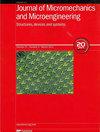用于提高二维 MEMS 传感器灵敏度的七形梁设计
IF 2.1
4区 工程技术
Q2 ENGINEERING, ELECTRICAL & ELECTRONIC
引用次数: 0
摘要
连接梁的刚度是影响 MEMS 传感器性能的最关键因素之一。许多传统方法通过改变连接梁的参数或数量来降低刚度。本文介绍了一种用于 MEMS 传感器的七形梁结构。七形结构的两段之间的锐角实现了较低的刚度。与蟹腿梁相比,通过不同的包含角设计,它能带来 1.29 倍的最大灵敏度增益。同时,与组合梁相比,七字形组合梁可带来 1.6 倍的最大灵敏度增益。利用七形光束,设计并制造出了二维 MEMS 传感器。实验结果表明,它的检测灵敏度达到了 25 fF/g。测量结果与模拟结果之间的差分电容变化相对误差仅为 8.6%。本文章由计算机程序翻译,如有差异,请以英文原文为准。
Seven-shaped beam design for improving the sensitivity of two-dimensional MEMS sensors
The stiffness of the connecting beam is one of the most crucial factors affecting the performance of MEMS sensors. Many traditional methods reduce the stiffness by changing the parameters or number of connecting beams. This paper introduces a seven-shaped beam structure used for MEMS sensor. The acute angle between its two segments of seven-shaped structure realizes lower stiffness. Compared with the crab-leg beam, it can bring a maximum sensitivity gain of 1.29 times through different included angle designs. At the same time, compared with the combined beam, seven-shaped combined beam can bring a maximum sensitivity gain of 1.6 times. By using the seven-shaped beam, the two-dimensional MEMS sensor has been designed and fabricated. According to the experimental results, it achieved a detection sensitivity of 25 fF/g. The relative error of the differential capacitance change between the measurement result and the simulation result is only 8.6%.
求助全文
通过发布文献求助,成功后即可免费获取论文全文。
去求助
来源期刊

Journal of Micromechanics and Microengineering
工程技术-材料科学:综合
CiteScore
4.50
自引率
4.30%
发文量
136
审稿时长
2.8 months
期刊介绍:
Journal of Micromechanics and Microengineering (JMM) primarily covers experimental work, however relevant modelling papers are considered where supported by experimental data.
The journal is focussed on all aspects of:
-nano- and micro- mechanical systems
-nano- and micro- electomechanical systems
-nano- and micro- electrical and mechatronic systems
-nano- and micro- engineering
-nano- and micro- scale science
Please note that we do not publish materials papers with no obvious application or link to nano- or micro-engineering.
Below are some examples of the topics that are included within the scope of the journal:
-MEMS and NEMS:
Including sensors, optical MEMS/NEMS, RF MEMS/NEMS, etc.
-Fabrication techniques and manufacturing:
Including micromachining, etching, lithography, deposition, patterning, self-assembly, 3d printing, inkjet printing.
-Packaging and Integration technologies.
-Materials, testing, and reliability.
-Micro- and nano-fluidics:
Including optofluidics, acoustofluidics, droplets, microreactors, organ-on-a-chip.
-Lab-on-a-chip and micro- and nano-total analysis systems.
-Biomedical systems and devices:
Including bio MEMS, biosensors, assays, organ-on-a-chip, drug delivery, cells, biointerfaces.
-Energy and power:
Including power MEMS/NEMS, energy harvesters, actuators, microbatteries.
-Electronics:
Including flexible electronics, wearable electronics, interface electronics.
-Optical systems.
-Robotics.
 求助内容:
求助内容: 应助结果提醒方式:
应助结果提醒方式:


